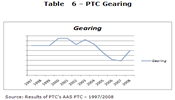Gearing corresponds to the company's financial structure and is determined by the weight of debt capital as a proportion of total invested capital, a methodology which has been followed by PTC. The determination of the company's financial structure is evidently very important in determining the WACC. The choice of the optimal ratio between equity and debt, in order to optimize the WACC, is known as the optimal capital structure.
PTC has calculated gearing using the ratio between debt, consisting of medium and long term debt, and invested capital (sum of debt capital and equity).
However, taking into account that PTC’s level of gearing has fluctuated widely over time (See Table 6), essentially because: (i) PTC does not hold medium and long term loans on a consistent basis and therefore its debt stems mainly from provision for retirement and health care benefits; and (ii) the basis used by PTC to calculate gearing is not the most appropriate, as outlined in the PwC report, ICP-ANACOM has deemed it necessary to adopt an alternative approach that is not impacted by the variations resulting from the financial management strategies pursued by the company's group.
Table 6 - PTC Gearing
The report prepared by PwC cites four methodologies which can be used to calculate gearing, and which have been used by European regulators: (i) real gearing, (ii) target gearing 1; (iii) optimal gearing; and (iv) regulatory precedent.
In general, it is observed that most European Regulators 2 have adopted optimal gearing, an option which has several advantages: (i) it increases predictability and regulatory certainty; and (ii) it eliminates the volatility of gearing in terms of the funding policies pursued by the companies, thereby promoting efficiency and transparency.
PwC 3 is of the same opinion, proposing the calculation of optimal gearing through a Benchmark.
It should be noted that optimal gearing can also be calculated by constructing a financial model that simulates the performance of the company for different levels of gearing, to maximize the value of the company. This model requires a large amount of information, which is not always available (e.g. company valuation, debt ratios, continuity of operations, etc.) and may require set of assumptions to be defined which are subjective in nature (e.g., analysis of the business, company book value or market value of the firm; debt fair value, etc.).
In this respect, and considering existing limitations, ICP-ANACOM deems that the most appropriate methodology consists of the use of a Benchmark.
In its report, PwC proposes the use of these two forms of benchmark to calculate this indicator: (i) comparable companies; and (ii) recent regulatory precedent (2008).
As regards the benchmark of comparable companies, to ensure the overall coherence of the proposed methodology, the comparable companies selected are the same as those used to determine the Beta, including PT SGPS (See Table 7) and five years of historical data was considered.
|
Company |
5 year average Gearing |
|
Belgacom |
30.05% |
|
BT Group |
63.08% |
|
Deutsche Telekom |
39.43% |
|
Elisa OYJ |
30.53% |
|
France Telecom |
46.76% |
|
Hellenic Telecommunications |
46.71% |
|
KONINKLIJKE KPN NV |
57.03% |
|
Magyar Telecom |
26.15% |
|
Swisscom |
43.50% |
|
Telekom Austria |
43.91% |
|
Telecom Italia |
54.55% |
|
Telefonica |
56.14% |
|
Telenor ASA |
31.02% |
|
TeliaSonera AB |
17.39% |
|
PT SGPS |
53.39% |
|
Average |
42.64% |
Source: PwC 2009 Report and Bloomberg
in terms of the Benchmark of regulatory precedent, the regulators selected 4 were those with recent decisions on the gearing for the fixed business (See Table 8).
|
Regulatory precedent |
|
2008 |
|
29.77% |
For the reasons already given with regard to the calculation of Beta, ICP-ANACOM considers that it is necessary to adopt gearing which is obtained from the average between benchmarks using comparable companies and regulatory precedent, determined as being 36.20% for the three-year period of 2009 - 2011.
1 See PwC Report 2009 - page 46.
2 IBPT, ARCEP, ComReg, Agcom and CMT.
3 See PwC report 2009 - pages 42 to 46.
4 See PwC Report 2009 - pg. 47.





